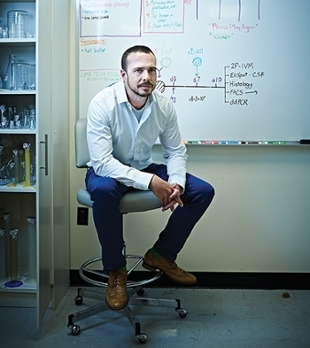A Multi-angled Approach to Research
Researchers are exploring multiple sclerosis from all angles to better understand, diagnose and treat the mysteries of the disease
By Emily Leighton, MA’13
You’re sitting at a table in a plain room.
A researcher sits directly across from you, ready to begin the series of testing activities you’ll be undertaking throughout the next hour.
She starts by reading a list of 16 words. You’re asked to repeat them back in any order. You remember the vegetables easily – celery, spinach and cabbage. You close your eyes, trying to recall the other words.
Celery, spinach, cabbage…
Next, you’re shown a paper with six abstract shapes. It’s only in front of you for 10 seconds. When you’re asked to draw the shapes as you remember them, your hand hovers above the paper.
Was that a triangle or a diamond? The image is hazy and just out of reach; the same way it feels when someone’s name is on the tip of your tongue.
“Cognition is often described as an invisible symptom in multiple sclerosis (MS),” explained Dr. Sarah Morrow. “It’s easy to write off because there isn’t a predictable decline like we see in dementia; it’s more episodic. It also presents differently from dementia – the first signs people notice are usually difficulty processing information or not remembering things unless they are written down.”
Dr. Morrow, an associate professor with Clinical Neurological Sciences and a neurologist at London Health Sciences Centre and St. Joseph’s Health Care London, is studying the cognitive changes associated with MS. She established the first MS cognitive clinic in Canada, based out of the Parkwood Institute at St. Joseph’s.
Looking at cognition from a clinical perspective, Dr. Morrow and her team are working to better understand, assess and treat these lesser-known, debilitating symptoms.
 Cognitive testing with MS patients is a big part of their work, both for clinical use and research. Patients undergo a series of testing batteries – collections of tasks and questionnaires – that assess various domains, including processing speed, memory and higher executive functioning.
Cognitive testing with MS patients is a big part of their work, both for clinical use and research. Patients undergo a series of testing batteries – collections of tasks and questionnaires – that assess various domains, including processing speed, memory and higher executive functioning.
On the research side, Dr. Morrow is leading several treatment studies to try and improve cognition in MS patients.
MS remains a mystery in many ways, despite decades of research. It is thought to be an autoimmune disease of the central nervous system – the immune system attacks healthy cells in the body – but who gets it and why is not clear.
“Every person with MS is different, the disease is unique, and we still don’t have good predictors of who will get the disease and why, or who will experience cognitive impairment and why,” said Dr. Morrow. “The uncertainty makes it very scary.”
Dr. Morrow is partnering with Robarts Research Institute scientist Ravi Menon, PhD, Canada Research Chair in Functional Magnetic Resonance Imaging, to answer questions that have arisen from her clinical experience. The duo is looking to better understand why cognitive issues occur and how they present.
“We don’t know if these problems come from the brain’s white matter or grey matter,” explained Menon. “And we want to know why some people have lots of lesions and no cognitive deficits while others have only one lesion but significant problems.”
An international leader in ultra high-field magnetic resonance imaging (MRI), Menon is looking at two different areas of MS research – early diagnosis and disease prognosis. His research brings together a number of researchers from across Western University and London’s teaching hospitals.
On the diagnosis side, Menon is developing imaging techniques to identify early indicators of MS, including iron deposition, demyelination and cortical lesions.
As part of a longitudinal study, his team is following a group of 50 people with suspected MS, also called clinically isolated syndrome. Using 7T MRI imaging, Menon’s team at the Centre for Functional and Metabolic Mapping uses special MRI pulse sequences to look for the microscopic signatures of the disease.
“Once we’ve imaged the patients, we wait to see if the disease progresses or not with traditional clinical signs,” he said. “So we can retrospectively see if our imaging signs worked to predict the disease.”
The other focus of Menon’s work is prognosis. Disease behaviour in MS varies significantly, from a few bad days here and there when symptoms flare up to a more progressive form where patients decline steadily from the outset.
Through a ‘watchful waiting’ longitudinal study with another 50 participants, Menon and his team, in collaboration with Dr. Morrow, are trying to identify imaging and cognitive biomarkers that may predict how the disease will progress.
“We’re trying to understand autoimmune choices. We look at cells in the spinal cord to see where they came from, which cells they are interacting with, and how they become activated.”
—Steven Kerfoot, PhD
For now, much like the diagnosis study, Menon relies on comparing the collected images to the type of MS developed over the longer-term.
“We can look backward and predict from our early scans what the course of the disease is going to be,” Menon explained. “If we know this information, we can potentially tailor medications and treatment earlier on.”
Steven Kerfoot, PhD, associate professor of Microbiology and Immunology, is also asking fundamental questions about MS, but his focus is the immune system and the possible triggers of the disease.
He is part of the multi-disciplinary research team exploring the disease and is looking at basic B cell biology – immune cells that are known to produce antibodies, but may also play an important role in directing and controlling immune response.
Kerfoot and his team are specifically trying to understand how B cells contribute to initiating and maintaining the chronic immune response that is responsible for damage to the central nervous system in MS.
“We’re trying to understand autoimmune choices,” he explained. “We look at cells in the spinal cord to see where they came from, which cells they are interacting with, and how they become activated.”
Using ‘realistically complex’ animal models of the disease developed by his lab, Kerfoot is delving deeper into questions about who develops chronic MS and who does not, and why that might be.
With access to the world-class imaging facilities and tools at Robarts, he is comparing disease progression in these animal models to humans, tapping into Menon’s imaging expertise and current studies.
“We want to see if Ravi’s findings translate to predicting which of our animal models will develop chronic disease and which ones will have a simple, monophasic, one attack disease,” said Kerfoot. “If they do, our models become tools to start digging into the immunology to try to understand what’s driving those differences, and the biological decision of immune cells.”
Kerfoot is also partnering with clinical colleagues Dr. Morrow and Dr. Marcelo Kremenchutzky, a neurologist and former director of the London MS Clinic, on several research projects – an example of the inclusive approach to research that advances knowledge of MS across a wide spectrum of fields and specialties.
“These collaborations allow us to take our research further than we could on our own,” said Kerfoot.
Dr. Kremenchutzky agrees. “MS is such a complex condition that if you’re only looking at it from one angle, you’re missing the whole, big picture,” he said. “Our aim is to translate findings in fundamental research to medical practice and provide meaningful outcomes for people living with MS and their families.”
1/340 Canadians
Canada has the highest rate of multiple sclerosis (MS) in the world, with an estimated 1 in 340 Canadians living with the disease according to Statistics Canada.
Ninety-three Thousand and Five hundred
It is estimated that approximately 93,500 Canadians are currently living with MS, according to Statistics Canada’s Canadian Community Health Survey (2010–2011).
15-40 Years
MS is most often diagnosed in young adults aged 15 to 40, and it is three times as likely to occur in women as in men.









